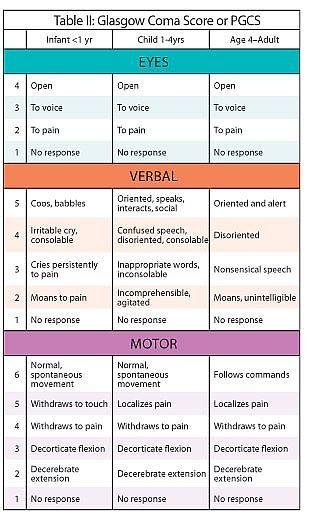- Glasgow Coma Scale For Pediatrics
- Glasgow Coma Scale For Paediatrics
- Glasgow Coma Scale Chart Pediatric
The Paediatric Glasgow Coma Scale (British English) or the Pediatric Glasgow Coma Score (American English) or simply PGCS is the equivalent of the Glasgow Coma Scale (GCS) used to assess the level of consciousness of child patients. Pediatric Glasgow Coma Scale (pGCS) Assesses impaired consciousness and coma in pediatric patients. Acknowledgments: The Child’s Glasgow Coma Scale has evolved from adaptations to Jennett and Teasdale’s Glasgow Coma Scale (1), by James and Trauner (2), Eyre and Sharples and by Tatman, Warren and Whitehouse (3), and paediatric nurse colleagues, Kirkham and the British Paediatric Neurology Association GCS Audit Group.
The Pediatric Glasgow Coma Scale was developed as a modification of the adult GCS Scale to objectively measure neurologic function in head injuries. It is intended for use in patients under 2 years old. The Pediatric Glasgow Coma Scale (also known as Pediatric Glasgow Coma Score or simply PGCS) is the equivalent of the Glasgow Coma Scale (GCS) used to assess the mental state of adult patients. As many of the assessments for an adult patient would not be appropriate for infants, the scale was modified slightly.
This content is only available to UpToDate subscribers. Please log in or subscribe to gain access.
Already a subscriber? Log in here
Not a subscriber? Subscribe now for immediate access

An UpToDate subscription provides unlimited online access to topics in over 22 specialties. With UpToDate, you can answer questions quickly, increase your clinical knowledge and improve patient care.
Your subscription includes:


- Evidence-based, peer-reviewed content developed by our faculty of over 5,700 leading physicians.
- Graded recommendations, so you can quickly assess the strength of the recommendation and the quality of the evidence behind it.
- Drug information, including interactions - UpToDate partners with Lexicomp® to provide you with information on over 5,100 individual drugs, including a tool to assess the compatibility of any combination of prescription, OTC or herbal medications.
- Effortless CME - Earn AMA PRA Category 1 Credit™, AAFP Prescribed credit, AAP credit, AOA credit, AAPA credit, ACEP credit, ACOG cognates, CFPC Mainpro®-M1 credit and AANP contact hours at no extra cost.
- Patient education - UpToDate helps you educate your patients with nearly 1,000 patient education topics, ranging from basic overviews to more in-depth information for patients wanting more detail.

Your UpToDate subscription is risk-free. If you are not completely satisfied, simply cancel within 60 days for a full refund in US dollars.
| Paediatric Glasgow Coma Scale | |
|---|---|
| Synonyms | Pediatric Glasgow Coma Score |
| Purpose | assess the level of consciousness of child |
The Paediatric Glasgow Coma Scale (British English) or the Pediatric Glasgow Coma Score (American English) or simply PGCS is the equivalent of the Glasgow Coma Scale (GCS) used to assess the level of consciousness of child patients. As many of the assessments for an adult patient would not be appropriate for infants, the Glasgow Coma Scale was modified slightly to form the PGCS. As with the GCS, the PGCS comprises three tests: eye, verbal and motor responses. The three values separately as well as their sum are considered. The lowest possible PGCS (the sum) is 3 (deep coma or death) whilst the highest is 15 (fully awake and aware person). The pediatric GCS is commonly used in emergency medical services.
Coma scale[edit]
| 1 | 2 | 3 | 4 | 5 | 6 | |
|---|---|---|---|---|---|---|
| Eyes | Does not open eyes | Opens eyes in response to painful stimuli | Opens eyes in response to speech | Opens eyes spontaneously | N/A | N/A |
| Verbal | No verbal response | Inconsolable, agitated | Inconsistently inconsolable, moaning | Cries but consolable, inappropriate interactions | Smiles, orients to sounds, follows objects, interacts | N/A |
| Motor | No motor response | Extension to pain (decerebrate response) | Abnormal flexion to pain for an infant (decorticate response) | Infant withdraws from pain | Infant withdraws from touch | Infant moves spontaneously or purposefully |
Best eye response: (E)[edit]

- 4. Eyes opening spontaneously
- 3. Eye opening to speech
- 2. Eye opening to pain
- 1. No eye opening or response
Best verbal response: (V)[edit]
- 5. Smiles, oriented to sounds, follows objects, interacts.
- 4. Cries but consolable, inappropriate interactions.
- 3. Inconsistently inconsolable, moaning.
- 2. Inconsolable, agitated.
- 1. No verbal response.
Glasgow Coma Scale For Pediatrics
Source:[1]
Best motor responses: (M)[edit]
- 6. Infant moves spontaneously or purposefully
- 5. Infant withdraws from touch
- 4. Infant withdraws from pain
- 3. Abnormal flexion to pain for an infant (decorticate response)
- 2. Extension to pain (decerebrate response)
- 1. No motor response
Any combined score of less than eight represents a significant risk of mortality.
See also[edit]
References[edit]
- Merck Manual. 'Modified Glasgow Coma Scale for Infants and Children'. Retrieved 2008-05-03.
Glasgow Coma Scale For Paediatrics
- ^'Archived copy'. Archived from the original on 2016-01-22. Retrieved 2020-04-29.CS1 maint: archived copy as title (link)
Glasgow Coma Scale Chart Pediatric
